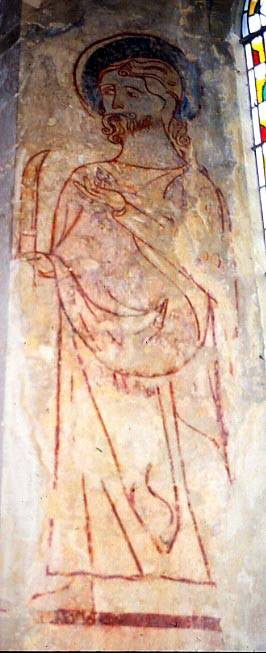Selling, Kent (†Canterbury) Early C.14
St Bartholomew and St John the Evangelist

Pictured at the right is St Bartholomew. This is a rare sighting of the saint, who is not common anywhere. There is a 13th century painting of him in a window splay, much mutilated, at Tidmarsh in Berkshire, again paired as here with St John the Evangelist, and one in a splay beside the Doom at Chalgrove in Oxfordshire, where, in a painting contemporary with this one, he is paired with St Laurence. At Maresfield in Sussex, a church dedicated to Bartholomew, a 12th century painting, thought to be of his Martyrdom, is recorded, but that church was radically restored in 1878/9 and its paintings lost.

But the Selling painting of him is the clearest and most complete of all the paintings of Apostles – Peter and Paul¹ are also shown – in the church. He holds up the instrument of his martyrdom, the knife with which his skin was flayed from his body, gesturing towards it with his left hand. His hair and beard are curly and his robes are the generalised kind seen in representations of Apostles who have no specific association with clerical vestments, as indeed are those of St John the Evangelist below.
John, pictured left, is as usual a youthful figure (the painter has suggested a downy fuzz on his chin, hard to see clearly here). In his left hand he once held a book, now gone with damaged plaster, and in his right he has a long scroll, which curves down beside him to rest on the head of his attribute, the Eagle, painted below at his feet. The figure is superimposed on a grid-like ‘stoning and roses’ pattern, found, along with a plain masonry pattern, quite extensively in other parts of the church (all the Apostle paintings are in the south transept).
Peter and Paul, the two other Apostles, are also reasonably clear, and they are now on this site. Also at Selling is a magnificent East Window, bricked up at the Reformation, hence its survival, in the chancel. It has a fine Virgin and Child, along with other saints and various coats-of-arms, some of them royal. These have been identified as the arms of Edward 1 (1272-1302), and the window itself is generally reckoned to have been installed in around 1300. The paintings are perhaps a little later, but I think they date from the first, rather than the second, half of the 14th century.
Website for St Mary the Virgin, Selling
¹ Although not one of the original twelve, often found in their company in medieval times